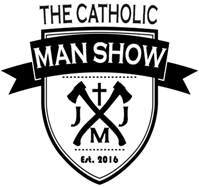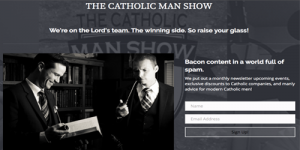Adam & David call the police at church and Adoration
Adoration – The history and what to do during the time.
We are looking for a few men who are taking their faith seriously.
Become a Patron!
New post on patreon – Men’s talk by Dr. Edward Sri
If you enjoyed this episode us on Patreon: Extra content, great thank you gifts, exclusive access to Adam and David, private FB page, and much more.
About our drink:
Yamato was created by Aiko Importers after contacting one of the largest distilleries in the Yamanshi Prefecture and learning of excess barrels of Japanese Whisky that had not been assigned to a market and could be acquired. Aiko, under Japanses authority, was able to contract for this whisky, and developed the Yamato label to be bottled exclusively as a Small Batch Japanese Whisky. This whisky is a blend of malted barley Scotch whisky and selected Japanese grain that was grown in the Yamanashi Prefecture. The cold winters and fiery summers gives a rich flavour quality to the grain. The unique geographical location allows the whisky an intense maturation period, thereby losing a considerable amount as the “angel’s share”. To maintain the products natural character it is non-chill filtered. It is a blend of 3-8 year old whiskies aged in Mizunara Oak barrels.
| Official Nose: | Distinctly confident liquorice-bourbon notes with near perfect bitter-sweet balance; burnt honeycomb and toffee also abound. |
| Official Taste: | Outstanding richness and sheen to the enormous barley-oak sweetness; again there is big bourbon influences with all the associated liquorice and molasses sugar. The barley adds an extra dimension. |
| Official Finish: | Long, wonderfully layered oak, offering variations on the sweet/dry theme, with some creamed toffee at the death. |
About our gear:
Candle by the hour – Candle by the Hour draws it’s inspiration from the historical courting candle, which was popular among families in the 16th-18th centuries. Courting candles traditionally used during the courtship of a young woman by a suitor, where the suitor would know that it was time to say his goodbyes after the candle had burned down to the metal clip or base. Candle by the Hour provides a unique glimpse into the culture of past generations while providing a warm light in the contemporary home!
About our topic:
Fermentum – goes back as early as 120 AD. The rite of fermentum was a particle of Eucharistic bread transported from the bishop of one diocese to the bishop of another diocese. The latter would then consume the species at his next solemn Mass as a token of unity between the churches. It wasn’t viewed as a symbol but as a reality.
Hermits (who were not priests) would worship the Eucharist in caves and take the Eucharist with them to avoid animals or thieves.
As monasticism changed from solitary to communal life, monks would carry the Eucharist with them working in the fields or going on a voyage.
It is interesting to note that one of the first unmistakable references to reserving the Blessed Sacrament is found in a life of St. Basil (who died in 379). Basil is said to have divided the Eucharistic Bread into three parts when he celebrated Mass in the monastery. One part he consumed, the second part he gave to the monks, and the third he placed in a golden dove suspended over the altar.
In the turn of the first century, an archdeacon, Berengarius, publicly denied that Christ was really and physically present under the species of bread and wine. Pope Gregory VII ordered Berengarius to sign a retraction and Pope Gregory wrote the following (quoted in Pope Paul VI’s document Mysterium Fidei):
“I believe in my heart and openly profess that the bread and wine placed upon the altar are, by the mystery of the sacred prayer and the words of the Redeemer, substantially changed into the true and life-giving flesh and blood of Jesus Christ our Lord, and that after the consecration, there is present the true body of Christ which was born of the Virgin and offered up for the salvation of the world, hung on the cross and now sits at the right hand of the Father, and that there is present the true blood of Christ which flowed from his side.They are present not only by means of a sign and of the efficacy of the Sacrament, but also in the very reality and truth of their nature and substance.”
With this profession of faith, the churches of Europe began what can only be described as a Eucharistic Renascence. Processions of the Blessed Sacrament were instituted; prescribed acts of adoration were legislated; the cells of anchoresses had windows made into the church to allow the religious to view and adore before the tabernacle.
There was nothing startling, therefore, when Pope Urban IV, in the thirteenth century, instituted the feast of Corpus Christi. When establishing the feast, the Pope stressed the love of Christ who wished to remain physically with us until the end of time.
Urban IV commissioned Thomas Aquinas to compose the Liturgy of the Hours for the feast of Corpus Christi, to be celebrated annually on the Thursday following Trinity Sunday.
During the thirteenth century, scholastic theologians debated whether a person in the state of mortal sin could worthily gaze upon – or be in the presence of – a cost exposed for adoration. It was decided that it was not only permissible, but praiseworthy – and many theologians thought that “if it were done with a reverent intention, it was likely to obtain for the sinner the grace of true contrition.”
“The only-begotten Son of God is to be adored in the Holy Sacrament of the Eucharist with the worship of latria, including external worship. The Sacrament, therefore, is to be honored with extraordinary festive celebrations (and) solemnly carried from place to place in processions according to the praiseworthy universal rite and custom of the holy Church. The Sacrament is to be publicly exposed for the people’s adoration.” Approved by Pope Julius III (October 11, 1551), these conciliar statements became the foundation for dogmatic and devotional progress ever since.
Five graces of the Holy Eucharist: 1. Spiritual Peace, 2. Forgiveness/healing, 3. Transformation in His image, 4. Unity within the mystical body, and 5. Everlasting life. Many of these graces are also present through extra liturgical worship of the Eucharist – particularly adoration and benediction. Saint John Chrysostom spoke of the joy, consolation, and hope that comes from reverencing the Sacrament: “When you see It (the Body of Christ) exposed, say to yourself: thanks to this Body, I am no longer dust and ashes, I am no more a captive but a freeman: hence I hope to obtain Heaven and the good things that are there in store for me, eternal life, the heritage of the Angels, companionship with Christ.”
[youtube https://www.youtube.com/watch?v=UnNAcWnnKkc]
About our drink: Yamato Whiskey
About the gear: Candle by the Hour
About our topic: Adoration
If this is your first time listening to The Catholic Man Show, we do 3 things almost every episode:
TIME CODES:
1.) Open, review, and enjoy a man beverage – Minutes 1-12.
2.) Highlight a man gear – Minutes 12-24.
3.) Have a manly conversation – Minutes 24-48.
If you haven’t listened to The Catholic Man Show before, check out our previous episodes here.
Subscribe to our YouTube channel to watch past episodes.
OnlineGreatBooks.com provides accountability, curation, community, and personal growth. SIGN UP USING PROMO CODE, “CATHOLICMAN” AND GET 25% OFF THE FIRST 3 MONTHS.
Want to help The Catholic Man Show?
By giving us a rating on iTunes, it helps others find the show.
Want to say up with The Catholic Man Show? Sign up for our mailing list: Click Here
Looking for a prayer to pray with your wife? Check this blog out.
Are you getting our emails? Sign up for our (almost) monthly newsletter where we give you all bacon content – never spam.
If you enjoyed this episode of The Catholic Man Show on spiritual warfare and are looking to protect your family from the dangers of the internet, go to Covenant Eyes and use promo code “Catholicman” for a 30-day free trial of keeping your family safe.



